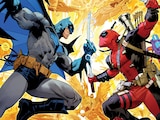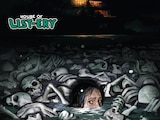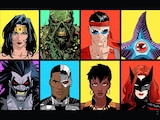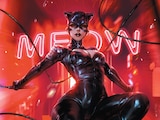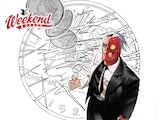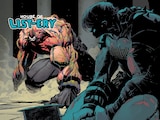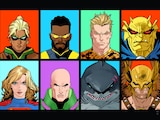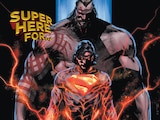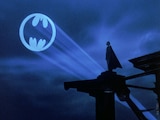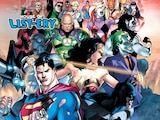Another month, another mystery. Welcome back to another edition of ASK…THE QUESTION—our regular feature where you, the members of our DC Community, can consult an expert to get answers to any question you may have about the DC Universe. I’m Alex Jaffe, better known to the community as HubCityQuestion, and I have the honor of being that very expert, tapping into my knowledge of the vast lore of the comic book multiverse and beyond. Below are some of my favorite questions I’ve received in recent weeks, but if your answers aren’t met in this column, you can always find me in my offices. Now, let’s get to the questions!
Breaking Up is Hard to Do

Wrightline1.42841 asks:
Just how many times has the Justice League officially disbanded?
So, you may have heard that in “Dawn of DC,” the Justice League is taking a bit of a break. Just how long that will last is anyone’s guess, but it likely isn’t the end of the Justice League forever. After all, the team has broken up many times.
For this count, I’m not including any sort of fakeout storylines where the League “disbands” before immediately getting back together; there has to be some kind of hiatus, or at least a significant shift. Some of these may be more subjective than others, but this is the best list I can provide within my reckoning. With all that in mind, here’s my tally:

- 1984, Justice League of America Annual #2: The original JLA disbands, as the original members find themselves too busy to fully commit themselves to the team. The “Justice League Detroit” era begins with Marian Manhunter leading a new team of heroes.
- 1987, Justice League of America #261: J’onn’s Detroit Justice League disbands during the Legends event where the world is turned against its superhero population, giving way to the team which would become Justice League International.
- 1992, Justice League America #60: This marks the end of Keith Giffen and JM DeMatteis’s “Justice League International” saga, where most of the team goes its separate ways before Booster Gold, Blue Beetle and Guy Gardner start it over from scratch.

- 1996, Justice League America #113: The next four years after the disbanding of Maxwell Lord’s Justice League are a tumultuous period involving multiple factions, including a reformed Justice League America, a new Justice League International formed from the ashes of Justice League Europe, a covert Justice League Task Force, and the radical Extreme Justice. All four teams could claim some authority as a Justice League in their own right, but the flagship Justice League America called it quits as the original JLA once did before them to attend to their personal lives. The next decade would be defined by an A-List team of Justice Leaguers for the first time since the team’s original incarnation disbanded, and for a long time it seemed like nothing could break them apart.
- 2005, JLA #120: That changed with the team-shattering revelations of Identity Crisis, where it was discovered that one half of the Justice League was keeping controversial procedures to protect themselves from super-villain vulnerability a secret from the other half. The schism was dire enough to break the team apart before Batman, Superman, and Wonder Woman would each embark on their own year-long soul-searching sabbaticals. A makeshift Justice League is briefly formed during 52, but it’s not around long enough for me to count it in good faith.
- 2009, Justice League of America #31: A reformed Justice League of America disbands after the apparent death of Batman in Final Crisis, with a violent splinter group led by Hal Jordan temporarily forming. It’s a significantly leaner team with a less traditional lineup.

- 2011, Justice League of America #60: After several roster changes, the Post-Final Crisis Justice League disbands in their final issue before the start of the New 52.
- 2022, Justice League #75: The Justice League has gone through many changes in the past decade, but the team hasn’t disbanded until it faced the Dark Army in the road to Dark Crisis. As in 52, a temporary Justice League was formed during the event, this time by Jon Kent, but immediately disbanded. Since the end of Dark Crisis, the Titans have taken the lead as the DC Universe’s premiere heroes.
Flash Philosophy

Jurisdiction asks:
Are Dawn and Don Allen heroes or villains?
Is Damian Wayne a hero or a villain? Is Tim Hunter? The paradox of the Tornado Twins, the children of Barry Allen yet to be born at the present time, is about the fact that the future is always mutable in the DC Universe. In some versions of the future, they become villains. In most others, they’re heroes. No person can be truly said to be good or evil from birth; all of us are shaped by our circumstances. In 2017’s The Flash #25, Professor Zoom tells Barry that the Tornado Twins would turn to evil in a future where he wasn’t present in their lives. This explicitly tells us that their future is still yet to be determined. Hopefully, Barry has learned enough from this dire portent of the years to come to be as attentive a father to his kids as Wally West has been to his own.
Cats Crossing Paths

Harper.Row asks:
Have Catwoman and Catman ever met?
They have indeed! Although Catman’s debut occurred during a protracted absence by Catwoman from Gotham City during the Silver Age, his first encounter with his feminine counterpart was in 1980’s Batman #322-324. When a string of crimes seems to be perpetrated by a reformed Catwoman, she discovers that the frame-up was actually the work of one Thomas Blake. Catman returns to seek revenge on Batman and Catwoman for foiling him in Detective Comics #509.
In 1990’s Detective Comics #612, Catwoman is accused of a murder actually perpetrated by Catman’s escaped Siberian tiger, which sends Catwoman after him to clear her name. They cross paths once more in “Heat,” a four-part crossover in Legends of the Dark Knight #46-49. In the three-part 1995 crossover “The Secret of the Universe,” Catwoman is hired to steal Catman’s mystic cloak of nine lives.
The most recent encounters between these feline rivals have been a bit more, shall we say, animated. In 1997, the Batman: The Animated Series tie-in comics gave us their own take on the original Catwoman/Catman story of Thomas Blake stealing Selina’s MO in The Batman & Robin Adventures #16. 2018’s Catwoman/Tweety & Sylvester featured a grand brawl between all the cat and bird-themed characters of the DC Universe, Selina and Thomas included. And in 2021, Selina proved that cats and dogs can work together when she joined forces with Scooby and the gang against Catman in The Batman & Scooby-Doo Mysteries #7 and #12.
Sidekickin’ It

Rex Rebel asks:
Not sure this is answerable, but I assume Robin as a character has the most sidekick appearances. But what non-Robin characters are in the top five of sidekick appearances? If possible, I am referring to issues where they actually appear as a sidekick, not on a team like the Teen Titans. If it can’t be separated that’s fine too.
As a side question, can you break out the various Robins by appearances as a sidekick?
I’m afraid it would take more time than I can afford to provide absolutely precise figures, but I can give you a pretty accurate ranking estimation. The number one name on this list by far would be Roy Harper, who fought crime by Green Arrow’s side for thirty years. That’s somewhere between 300-400 sidekick appearances before he hung up his hat and broke away as Arsenal, even discounting Teen Titans adventures.
Trailing him would be Pat Dugan, who’s been playing the sidekick role to this day since 1941—longer than anybody in the game. Even in team books, Stripesy has always been branded as the sidekick to the Star-Spangled Kid, and subsequently Stargirl, for just around 300 appearances (and counting).

After Pat comes Barbara Gordon, the only prominent Bat-Family member outside the Robins who spent an amount of time as Batman’s “sidekick” significant enough to rank on this list. Across all media depicting her as working specifically with Batman, I’d estimate that around 200-250 sidekick appearances take place before Barbara fully became her own hero, depending how you count her affiliation.
That brings us to two other founding members of the original Teen Titans, Aqualad (Garth) and Kid Flash (Wally West). Each of them clocked about 100 issues as a sidekick. Of the two, Garth probably has slightly more, but only just. (Donna Troy fans, of course, will know that she hardly ever worked with Wonder Woman at all.)
Just breaking out the Robins, our top five leaders in sidekick hours are as follows:
- Dick [1940-1982]
- Tim [1989-2009, some recent]
- Damian [2009-present, intermittent]
- Jason [1983-1988]
- Stephanie [Six months in 2004. But it still matters to us.]
Don’t Touch That Dial

leemerryman1.18797 asks:
I have been reading older DC titles from the ’30s. I have noticed many stories end mid-cliffhanger. Why was this so common? Was the writer just not sure where to go with it? It all feels very random.
It may seem like many of these early comic serials come to an end on a cliffhanger, but I’d like you to participate in an exercise for me: try reading each chapter of that early comic individually and see what happens. I think in most cases, you’ll find that not just the finale, but every single installment of the feature would end on a cliffhanger.
You see, prior to 1935, the only kind of popular comic which existed was the newspaper serial. These comics were designed to keep you reading from one day or one week to the next, ensuring your subscription money. With the invention of the comic book as we know it today in New Fun Comics, these early stories were written with that newspaper serial ethos, where the guiding principle was that you had to keep the reader interested in how the situation would resolve in every chapter. So there really was no concept of satisfactorily “wrapping up” a story when every comic was launched with the idea that it would run indefinitely.
But, the business being what it is, creative teams would find themselves reassigned, or changing tactics to address a more popular trend, or leaving the fledgling industry entirely for something more stable at a moment’s notice. The job was never to end a story, but to keep people reading. And in those early years of comics, no one really knew what the next month would bring. Everyone was trying to find the magic formula that would reliably get audiences hooked. And to a certain extent, it’s still something you see in comics today. Even as a case comes to a close, the likes of Batman and Superman are always on the verge of embarking on their next adventure.
Which provides the perfect segue for me to tell you all to make sure you don’t miss next month’s column for a new offering of questions to ease your troubled minds! Until then, I’m always available on the internet for your consultation. It is my pleasure to serve whenever you ASK…THE QUESTION.
Alex Jaffe is the author of our monthly "Ask the Question" column and writes about TV, movies, comics and superhero history for DC.com. Follow him on Twitter at @AlexJaffe and find him in the DC Community as HubCityQuestion.
NOTE: The views and opinions expressed in this column are solely those of Alex Jaffe and do not necessarily reflect those of DC Entertainment or Warner Bros., nor should they be read as confirmation or denial of future DC plans.

